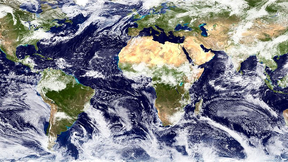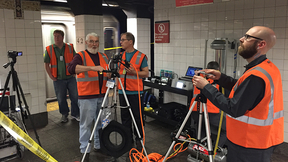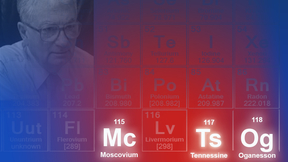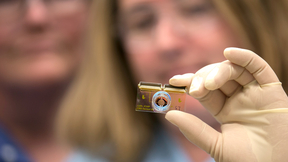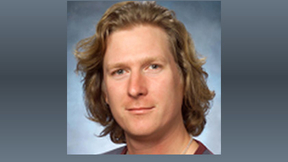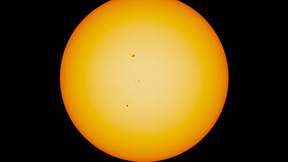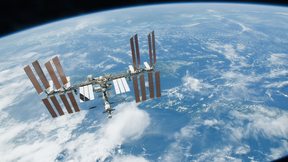Back
Physical and Life Sciences
Pitt engineers will use Lab's electron microscope to study rapid metal solidification
University of Pittsburgh engineers will utilize a unique transmission electron microscope developed and housed at Lawrence Livermore National Laboratory (LLNL) to better understand how microstructures form in metals and alloys as they solidify after laser beam melting. Under a three-year, $500,000 grant from the National Science Foundation, Jörg Wiezorek, a professor of…
Lawrence Livermore COLLECTS funding to improve solar power efficiency
Lawrence Livermore National Laboratory (LLNL), in collaboration with Giant Leap Technologies, received $1.75 million Thursday from the Department of Energy’s Office of Energy Efficiency and Renewable Energy to improve solar power efficiency. The project is part of DOE’s SunShot Initiative, which is a collaborative national effort that aggressively drives innovation to make…
Lab team measures peripheral nervous system activity with microchip-based platform
For the first time, Lawrence Livermore National Laboratory (LLNL) researchers have successfully incorporated adult human peripheral nervous system (PNS) cells on a microelectrode platform for long-term testing of chemical and toxic effects on cell health and function. The study, part of a project known as iCHIP (in-vitro Chip-Based Human Investigational Platform), was…
Scientists find evidence for climate change in satellite cloud record
Scientists have found that changes in cloud patterns during the last three decades match those predicted by climate model simulations. These cloud changes are likely to have had a warming effect on the planet. Records of cloudiness from satellites originally designed to monitor weather are plagued by erroneous variability related to changes in satellite orbit, instrument…
Lab's high performance computing will play major role in Cancer Moonshot initiative
Vice President Joe Biden and his wfie Jill Biden hosted the Cancer Moonshot Summit Wednesday to announce several efforts to expand cancer research in hopes of finding a cure. The Cancer Moonshot is a new national effort to double the rate of progress - to make a decade's worth of advances in cancer prevention, diagnosis, treatment and care in five years - and to ultimately…
Lab engineers garner DOE tech transfer awards
The Department of Energy (DOE) recently announced the selection of two proposals from Lawrence Livermore National Laboratory (LLNL) researchers for grants under the department’s Technology Commercialization Fund (TCF), a program intended to help promising energy technologies move from national laboratories to the marketplace. DOE awarded LLNL engineer Brian Guidry a $432…
Putting pressure on 3D-printed structures
Through a series of dynamic compression experiments on additively manufactured (AM) structured lattices, a Lawrence Livermore National Laboratory team, supported by colleagues at Los Alamos National Laboratory, has found that the assemblies have unique properties not exhibited by disordered cellular materials. During the experiment, elastic deflection of the structure…
3-D printed polymer turns methane to methanol
Lawrence Livermore National Laboratory scientists have combined biology and 3-D printing to create the first reactor that can continuously produce methanol from methane at room temperature and pressure.The team removed enzymes from methanotrophs, bacteria that eat methane, and mixed them with polymers that they printed or molded into innovative reactors.The research, which…
LLNL supports NYC subway biodefense test
Lawrence Livermore National Lab (LLNL) researchers took to the New York City subway system May 9-13 to help study how a surrogate for a biological agent, such as anthrax, might disperse throughout the nation’s largest rapid transit system as a result of a terrorist attack or an accidental release. As part of a multi-agency test sponsored by the Department of Homeland…
Public comment sought on new element names
The International Union of Pure and Applied Chemistry (IUPAC) opened a public comment period Wednesday for the recommended names of elements 115, 117 and 118.Lawrence Livermore National Laboratory and the the Joint Institute for Nuclear Research in Dubna, Russia (JINR), were credited late last year for discovering elements 115 and 118. LLNL, JINR, Oak Ridge National…
'Human-on-a-chip' could replace animal testing
Development of new prescription drugs and antidotes to toxins currently relies extensively on animal testing in the early stages of development, which is not only expensive and time consuming, it can give scientists inaccurate data about how humans will respond to such agents. But what if researchers could predict the impacts of potentially harmful chemicals, viruses or…
Team IDs gene involved with fracture healing
New identification of a gene involved in the fracture healing process could lead to the development of new therapeutic treatments for difficult-to-heal injuries.Fracture healing involves communication between bone, muscle, vasculature and the thin membrane covering the outer surface of bones (periosteum) during the fracture repair. The periosteum contains stem cells that…
Study lays groundwork for arthritis prevention
Joint injury can lead to post-traumatic osteoarthritis (PTOA). In fact, about half of all people who rupture the anterior cruciate ligament (ACL) in their knee will develop PTOA within 10 to 20 years of the injury.But the molecular and cellular mechanisms leading to cartilage degeneration or PTOA due to trauma are not well understood.Recently, a team of scientists from…
Researcher cracks top 10 in 'most creative' list
Lawrence Livermore National Laboratory chemist Dawn Shaughnessy has been named No. 9 on Fast Company’s Top 100 Most Creative People in Business for 2016.Shaughnessy is the principal investigator of the Heavy Element Group, where she has worked as a nuclear and radiochemist since 2002. In December 2015, the International Union of Pure and Applied Chemistry added three new…
LLNL energy guru returns from Washington
Julio Friedmann never tired of seeing the monuments, memorials, the Capitol, the Mall, meetings in the West Wing of the White House and other historic buildings. As principal deputy assistant secretary for Fossil Energy for the Department of Energy since November 2013, Friedmann was on assignment in Washington, D.C., from Lawrence Livermore National Laboratory. He returned…
Zavarin named Director of Glenn T. Seaborg Institute
Mavrik Zavarin has been named the new Director of The Glenn T. Seaborg Institute (GTSI) in the Physical & Life Sciences Directorate. In this capacity, Mavrik will continue to develop the GTSI's mission to carry out cutting-edge research in areas key to LLNL's Nuclear Security and Energy & Environment mission areas, with an emphasis on providing opportunities for…
Lab plays role in striking view of Mercury transit
Around 13 times per century, Mercury passes between Earth and the sun in a rare astronomical event known as a planetary transit. The 2016 Mercury transit occurred on May 9 between roughly 4:12 a.m. and 11:42 p.m. PDT.NASA's stunning video of the transit of Mercury across the sun was made possible in part by work done by Lawrence Livermore scientists. Regina Soufli, a…
Research finds clues to uncanny electrical conductivity in Earth's mantle
A team of scientists, including one at Lawrence Livermore National Laboratory (LLNL), has found that the dehydration of chlorite is likely to be crucial in explaining the anomalously high electrical conductivity observed in the Earth’s mantle.The high electrical conductivity (EC) in the mantle wedge regions between depths of 40 and 100 km is often attributed to the aqueous…
DOE awards grants to early-career researchers
The Department of Energy on Tuesday named two Lawrence Livermore National Lab scientists among the winners of the prestigious DOE Office of Science’s Early Career Research Program (ECRP) awards, granting them up to $500,000 per year for five years.Félicie Albert, an experimental plasma physicist at the National Ignition Facility and expert in ultrafast X-ray sources and…
LLNL biodetection system bound for space
A biological detection system developed by Lawrence Livermore National Laboratory (LLNL) scientists that has found more than a dozen applications soon will be used in tests reaching a new frontier — outer space.The Lawrence Livermore Microbial Detection Array (LLMDA) is a versatile tool that has been employed for all kinds of studies, from analyzing the purity of infant…





